Table of Contents
- Package Contents
- Optional Accessories
- Product Introduction
- Overview
- Expansion Speakerphone/Microphone Connection
- Phone in Connection
- Audio Signal Receive Range
- Speakerphone LED Indicator
- Remote Control
- Installation
- Device Connection
- RS232 Connection
- Wall Mount Installation
- Operating the Camera
- Make a Video Call
- Make a Connection by AVer IP Finder App
- Operating the AVer PTZApp
- Install AVer PTZApp
- Use AVer PTZApp to Setup the Camera
- Use AVer PTZApp to Setup the Speakerphone
- Use AVer EZLive
AVer VC520 Pro User Manual
Displayed below is the user manual for VC520 Pro by AVer which is a product in the Video Conferencing Systems category. This manual has pages.
Related Manuals

VC520 Pro
User Manual

Federal Communications Commission Statement
NOTE: This equipment has been tested and found to comply with the limits for a Class A
digital device, pursuant to part 15 of the FCC Rules. These limits are designed to
pro-vide reasonable protection against harmful interference when the equipment is
operate din a commercial environment. This equipment generates, uses, and can radiate
radiofrequency energy and, if not installed and used in accordance with the instruction manual, may
cause harmful interference to radio communications. Operation of this equipment in a residential area
is likely to cause harmful interference in which case the user will be required to correct the interference
at his own expense.
FCC Caution: Any changes or modifications not expressly approved by the party responsible for
compliance could void the user's authority to operate this equipment.
This device complies with part 15 of the FCC Rules.
Operation is subject to the following two conditions:
(1) This device may not cause harmful interference, and
(2) this device must accept any interference received, including interference that may cause undesired
operation.
Warning:
This is a class A product. In a domestic environment this product may cause radio interference in
which case the user may be required to take adequate measures.
DISCLAIMER
No warranty or representation, either expressed or implied, is made with respect to the contents of this
documentation, its quality, performance, merchantability, or fitness for a particular purpose. Information
presented in this documentation has been carefully checked for reliability; however, no responsibility is
assumed for inaccuracies. The information contained in this documentation is subject to change
without notice.
In no event will AVer Information Inc. be liable for direct, indirect, special, incidental, or consequential
damages arising out of the use or inability to use this product or documentation, even if advised of the
possibility of such damages.
TRADEMARKS
“AVer” is a trademark owned by AVer Information Inc. Other trademarks used herein for description
purpose only belong to each of their companies.
COPYRIGHT
©2020 AVer Information Inc. All rights reserved.
All rights of this object belong to AVer Information Inc. Reproduced or transmitted in any form or by any
means without the prior written permission of AVer Information Inc. is prohibited. All information or
specifications are subject to change without prior notice.

NOTICE
SPECIFICATIONS ARE SUBJECT TO CHANGE WITHOUT PRIOR NOTICE. THE
INFORMATION CONTAINED HEREIN IS TO BE CONSIDERED FOR REFERENCE ONLY.
THE CONTENTS ARE SUBJECT TO CHANGE WITHOUT PRIOR NOTICE. IF THE CONTENT
IS WRONG, PLEASE INFORM US TO MAKE CORRECTIONS.
WARNING
To reduce risk of fire or electric shock, do not expose this appliance to rain or moisture.
Warranty will be void if any unauthorized modifications are done to the product.
Do not drop the camera or subject it to physical shock.
Use correct power supply voltage to avoid damaging camera.
Do not place the camera where the cord can be stepped on as this may result in fraying or
damage to the lead or the plug.
Hold the bottom of the camera with both hands to move the camera. Do not grab the lens or
lens holder to move the camera.
Remote Control Battery Safety Information
- Store batteries in a cool and dry place.
- Do not throw away used batteries in the trash. Properly dispose of used batteries through
specially approved disposal methods.
- Remove the batteries if they are not in use for long periods of time. Battery leakage and
corrosion can damage the remote control. Dispose of batteries safely and through approved
disposal methods.
- Do not use old batteries with new batteries.
- Do not mix and use different types of batteries: alkaline, standard (carbon-zi
nc) or
rechargeable (nickel-cadmium).
- Do not dispose of batteries in a fire.
- Do not attempt to short-circuit the battery terminals.
Contact Information
Global
AVer Information Inc.
www.aver.com
8F, No.157, Da-An Rd., Tucheng Dist.,
New Taipei City
Taiwan
Tel: +886-2-2269-8535
Fax: +886-2-2269-8537
USA
AVer Information Inc.
668 Mission Ct.
Fremont, CA 94539
www.averusa.com
Toll-free: 1(877)528-7824
Local: 1(408)263-3828
Support.usa@aver.com
AVer Information Europe B.V.
Westblaak 140, 3012KM,
Rotterdam, Netherland
Tel: +31(0)10 7600 550
Technical support:
EU.RMA@aver.com

Contents
Package Contents ................................................................................................... 1
Optional Accessories .............................................................................................. 1
Product Introduction ................................................................................................ 2
Overview ................................................................................................................. 2
Expansion Speakerphone/Microphone Connection ................................................ 3
Phone in Connection ............................................................................................... 4
Pan and Tilt Angle ........................................................................................... 4
Audio Signal Receive Range .................................................................................. 5
Speakerphone LED Indicator .................................................................................. 6
Remote Control ....................................................................................................... 7
Installation ............................................................................................................... 9
Device Connection .................................................................................................. 9
RS232 Connection ................................................................................................ 11
Wall Mount Installation .......................................................................................... 17
Operating the Camera .......................................................................................... 20
Make a Video Call ................................................................................................. 20
Make a Connection by AVer IP Finder App ........................................................... 20

Use SmartFrame Function ............................................................................ 22
What is SmartFrame? ................................................................................... 22
Two kinds of SmartFrame Function .............................................................. 22
How does SmartFrame Work ........................................................................ 23
Login .............................................................................................................. 24
Live Screen Operation................................................................................... 25
Setup the Preset ............................................................................................ 25
Select the Preset Position ............................................................................. 27
Camera Settings ............................................................................................ 28
Smart Frame .......................................................................................... 28
Auto Focus ............................................................................................ 28
Home Position ....................................................................................... 29
Sleep Position ........................................................................................ 29
Sleep Timer ........................................................................................... 29
On Screen Menu ................................................................................... 30
Camera Binding ..................................................................................... 30
Image Settings .............................................................................................. 31
Image Flip .............................................................................................. 31
Image Mirror .......................................................................................... 31

True WDR .............................................................................................. 32
Frequency .............................................................................................. 32
White Balance ....................................................................................... 33
Noise Reduction .................................................................................... 33
Brightness .............................................................................................. 34
Sharpness.............................................................................................. 34
Saturation .............................................................................................. 35
RS232 Setting ............................................................................................... 35
Video Format Setting ..................................................................................... 36
IP Stream Resolution ............................................................................. 36
Frame Rate ............................................................................................ 36
Bit Rate .................................................................................................. 37
RTSP ..................................................................................................... 37
RTMP ..................................................................................................... 39
Network Setting ............................................................................................. 40
DHCP ..................................................................................................... 40
Static IP .................................................................................................. 40
System Setting .............................................................................................. 41
Language ............................................................................................... 41

FW Update............................................................................................. 42
Reset Settings ....................................................................................... 43
Camera Reboot ..................................................................................... 44
Change Password ................................................................................. 45
SSL Certificate ....................................................................................... 46
Date Format ........................................................................................... 47
Time Format .......................................................................................... 47
Time Correction Mode ........................................................................... 48
Information ............................................................................................. 48
Audio Setting ................................................................................................. 49
Noise Suppression ................................................................................ 49
Automatic Gain Control ......................................................................... 49
Echo Cancellation .................................................................................. 50
Keyboard Noise Suppression ................................................................ 50
Phone In Jack ........................................................................................ 51
Operating the AVer PTZApp .................................................................................. 52
Install AVer PTZApp .............................................................................................. 52
Use AVer PTZApp to Setup the Camera ............................................................... 52
Set the Camera Number ............................................................................... 60

Hotkey Control ............................................................................................... 62
Home / Sleep Position ................................................................................... 63
ADDR / Protocol / Baud Rate ........................................................................ 63
OpenGL ......................................................................................................... 64
Use AVer PTZApp to Setup the Speakerphone .................................................... 65
Use AVer EZLive ................................................................................................... 66

1
Package Contents
Camera Unit Speakerphone Unit Remote Control Power Adapter
Power Cord*
USB 3.0 Cable Speakerphone
Cable (10m)
3.5 mm Audio
Cable (0.9m)
L-Mount
Bracket
Screws for
Mount
M4 x 8mm(x2)
1/4”-20
L=7.5mm(x2)
Drilling Paper Quick Guide Warranty Card
P/N: 303AU 340-AGR
46.00[1.81]
51.00[2.01]
Ø5.50[Ø0.22]
*The power cord will vary depending on the standard power outlet of the country where it is sold
Optional Accessories
RS232 Cable
(MINI DIN 9 to MINI DIN 8)
RS232 Cable
(MINI DIN 8 to D-Sub9)

2
Product Introduction
Overview
1
2 3 4 5 6 7 8
1
2
Status LED
Power on: Red light
Standby: Orange light
IR sensor
4
5
6
7
USB3.1 Type B port
RS232 in/out port
Ethernet port
DC 12V power jack
3 Speakerphone port(Blue cable) 8 Kensington Lock
91011 12 13
9 Speakerphone port
(For extended speakerphone
and microphone connection/
Red cable)
10
11
12
13
Phone in port
Line out port
Camera port(Blue cable)
Kensington Lock

3
Expansion Speakerphone/Microphone
Connection
There are 2 types of expansion solutions that can be extended from the VC520 Pro speakerphone.
Please purchase the expansion speakerphone and/or microphone directly from AVer or an AVer
reseller.
Expansion Speakerphone Requirements:
- VC520 Pro Firmware version: 1004.00 or later
- FONE540 Firmware version: 7000.34 or later
[Note]
The VC520 Pro can support up to two expansion speakerphones, however, the daisy-chain
expansion cable cannot exceed over 40m in total.
Please connect the power supply for the expansion speakerphone when daisy-chaining over 20m.
Please connect the power supply when upgrading the firmware for the expansion speakerphone.
The expansion speakerphone cannot be used as the main speakerphone; it can only be used with
the VC520 Pro.
The speakerphone/microphone cables will be included in the package contents when the user
purchases the expansion speakerphone/microphone.
VC520 Pro speakerphone
Expansion speakerphone
Speakerphone cable
Expansion speakerphone
Power adapter
Microphone cable
Expansion
microphone
Expansion
microphone
Expansion
microphone
Expansion
microphone
VC520 Pro speakerphone

4
[Note] The VC520 Pro can support up to four expansion microphones, however, the daisy-chain
expansion cable cannot exceed over 40m in total.
Phone in Connection
Users can connect a mobile phone to the Phone in port on the speakerphone as a hands-free speaker.
When the device connects with the speakerphone, the icon will light up in blue. Touching the
icon will temporarily disconnect the connection of the device with the speakerphone; touching
the icon again will resume the connection.
Mobile phone
3.5mm audio cable
Pan and Tilt Angle

5
Audio Signal Receive Range
The best distance for the speakerphone to receive audio signal is within 7.5ft in radius. When
connecting two or more speakerphones, the distance between the speakerphones must be 9ft.

6
Speakerphone LED Indicator
Button LED Indicator Status
/ White light Adjust the volume up and down. When adjusting
the volume up and down, the volume LED indicator
will light up in blue.
White/Blue light Touch to mute/un-
mute the speakerphone volume.
In mute status, the LED indicator will light up in
red.
Red light Touch to hang up the call.
Green light Touch to answer the incoming call.
Blue light: Connects with
external device
White light: Temporarily
disconnects the
connection with the device
Off: No connection with
external devices
When the Phone in port connects with the device,
the LED indicator will light up in blue.

7
Remote Control
Name
Function
1. Camera Select One remote can control up to 3 AVer
VC/CAM/VB series cameras. You can
use AVer PTZApp to set numbers
associated with each camera, and then
select which camera you would like to
control using the remote.
[Note] If you only have one camera
that requires no additional setting, the
default is camera 1.
If camera 2 or 3 is selected, the remote
will be unable to control the camera.
In this case, please press camera 1 on
your remote.
2. Camera Direction
Control
Use the directional buttons on the
remote to control the direction of the
camera. Press the directional button to
move the camera or press and hold to
continuously pan or tilt.
3. SmartFrame One-click automatic FOV adjustment
to fit all participants.
Press and hold button on the
remote for 2 seconds to switch the
SmartFraming function between auto
and manual mode; a message (as
figure shown) will display on the screen
to indicate auto or manual mode.
[Note] While in the video conference
meeting, participants must face the
camera for proper face detection
(SmartFrame). Side facial profiles are
not detectable.
4. OSD Menu Not supported for VC520 Pro.

8
Name
Function
5. Zoom In/Zoom Out Increase/Decrease the camera zoom.
6. Preset 1. To save the camera at the desired
position, press and hold the preset
button until the "saved message" is
displayed on the PTZA
pp video
screen or other video apps. Select
preset position button 0 to 9 to save.
2. Press “preset” + “preset position
button” (0 ~ 9) to move the camera
to the saved position.
7. Preset Position Preset position buttons are used in
conjunction with the Preset button to
save positions. There are a total of
10 presets.
Press the preset button first and then
press 0~9 for the camera to move to
the saved position.
[Note]
Press and hold the number button
“” to turn the WDR function
on/off.
Press and hold the number” ”
button for one second to turn the
SmartFrame function on/off.
8. Brightness - Decrease the brightness.
9. Call/answer* Answer a call or start a call.
10. Enter Not supported for VC520 Pro.
11. Mute/Unmute
Speakerphone*
Mute/Unmute the speakerphone.
12. Volume Up/Down* Adjust volume up or down.
13. Preset Hot Key Press to move to a preset position
previously set by the user.
14. Brightness + Increase the brightness.
15. Hang Up* End the call.
* Function requires AVer PTZApp

9
Installation
Device Connection
1.
Connect the camera to power outlet.
Power cord
Power adapter
2.
Connect the camera to the speakerphone using the speakerphone cable included in the
package.
Speakerphone
cable
[Note]
The speakerphone port of the camera and the camera port of the speakerphone are both marked
in blue.
When connecting to the speakerphone, please remove the back port cover of the speakerphone
for successful cable connection. To remove the back port cover, simply pull off from the
speakerphone unit.
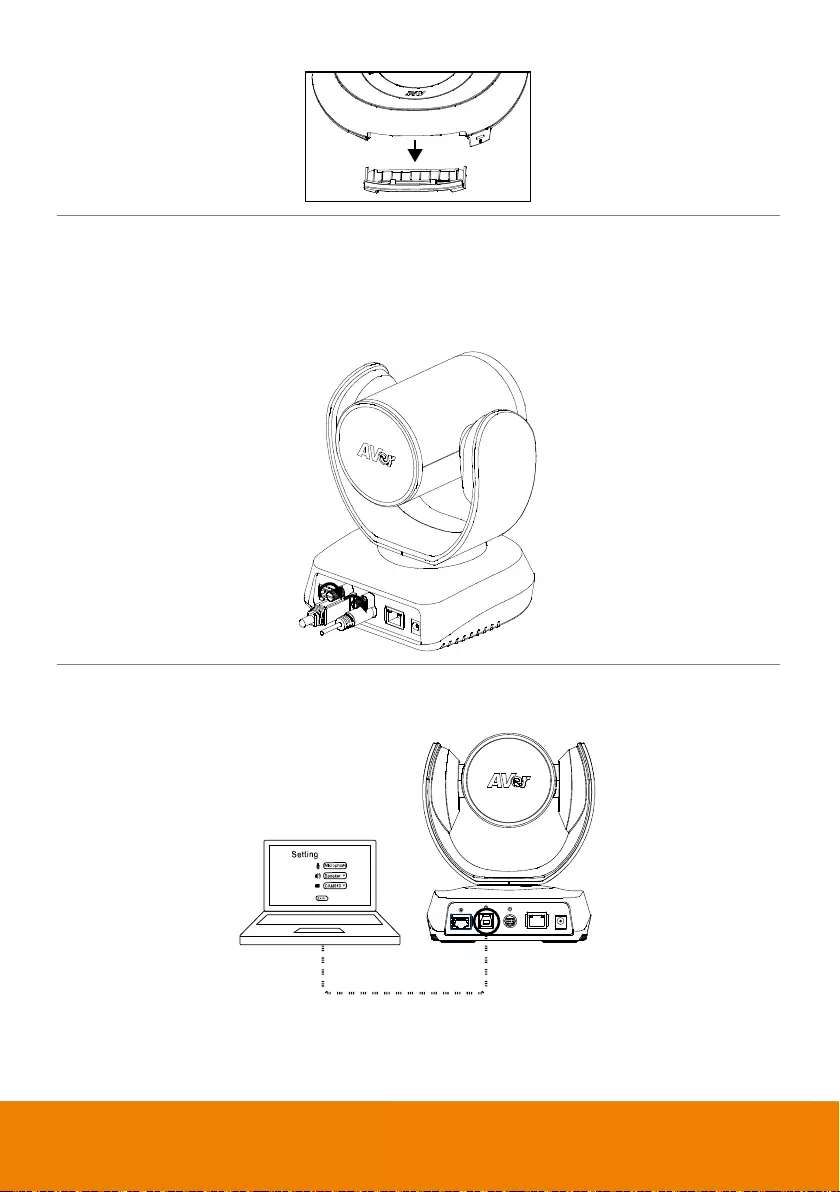
10
3.
Connect other necessary cables.
[Note]
USB and RS232 cable need to secure the cable with attached screw.
Make sure the cable is well connected to the connector on the camera before securing the
cable.
4.
Connect the camera to the computer.
[Note] Use the USB 3.0 cable that is included in package.
USB cable

11
RS232 Connection
Camera RS232 Port Pin Definition
1
2
3456
789
Function Mini DIN9
PIN # I/O Type Signal Description
VISCA IN
1 Output DTR Data Terminal Ready
2 Input DSR Data Set Ready
3 Output TXD Transmit Data
6 Input RXD Receiver Data
VISCA OUT
7 Output DTR Data Terminal Ready
4 Input DSR Data Set Ready
8 Output TXD Transmit Data
9 Input RXD Receiver Data
5 --- --- Not connect

12
Computer/Keyboard Controller and Camera Connection
Direct Connection
If users don’t buy AVer RS232 adaptor cable, please refer to the pin connection shown below.
Camera controller
or
Mini DIN9 Cable
Camera
(Mini DIN9)
Controller/PC
(DB9)
1. DTR(IN) 1. DCD
2. DSR(IN) 2. RXD
3. TXD(IN) 3. TXD
6. RXD(IN) 4. DTR
7. DTR(OUT) 5. GND
4. DSR(OUT) 6. DSR
8. TXD(OUT) 7. RTS
9. RXD(OUT) 8. CTX
9. RI

13
Use the RS232 mini DIN9 to mini DIN8 cable (Sold separately. Please purchase from AVer.).
Users can purchase AVer RS232 min DIN9 to mini DIN8 adaptor cable* to connect with Computer or
keyboard/controller.
1. RS232 (mini DIN9 to mini DIN8) adaptor cable (PN: 064AOTHERCDC)
2. Users can also purchase a miniDIN8 to D-Sub9 cable to connect with camera controller.
(PN: 064AOTHERBPK)
VISCA in(Female)
VISCA out(Female)
Camera controller
RS232 mini DIN9
to mini DIN8 cable
or
Mini DIN8 to D-Sub9 cable
1
2
Controller/PC
(DB9)
Camera
(Mini DIN8)
1. DCD 1. DTR(IN)
2. RXD 2. DSR(IN)
3. TXD 3. TXD(IN)
4. DTR 4. GND(IN)
5. GND 5. RXD(IN)
6. DSR 6. GND(IN)
7. RTS
8. CTX 1. DTR(OUT)
9. RI 2. DSR(OUT)
3. TXD(OUT)
4. GND(OUT)
5. RXD(OUT)
6. GND(OUT)

14
RS232 mini DIN9 to mini DIN8 Cable Pin Definition
Connect to AVer camera
Connect to next camera
Connect to controller or PC
IN(Mini DIN8)
OUT(Mini DIN8)
Mini DIN9
Mini DIN8 Pin Definition
No. Pin
1 DTR
2 DSR
3 TXD
4 GND
5 RXD
6 GND
7 NC
8 NC

15
Camera Cascade Connection
Direct Connection
If users don’t buy AVer RS232 adaptor cable, please refer to the pin connection shown below for
cascading cameras.
Total can connect up to 7 cameras.
1 2 7
Mini DIN9 Cable Mini DIN9 Cable Mini DIN9 Cable
Camera 1
(Mini DIN9)
Camera 2
(Mini DIN9)
1. DTR(IN) 1. DTR(IN)
2. DSR(IN) 2. DSR(IN)
3. TXD(IN) 3. TXD(IN)
6. RXD(IN) 6. RXD(IN)
7. DTR(OUT) 7. DTR(OUT)
4. DSR(OUT) 4. DSR(OUT)
8. TXD(OUT) 8. TXD(OUT)
9. RXD(OUT) 9. RXD(OUT)
SHIELD SHIELD

16
Use the RS232 mini DIN9 to mini DIN8 cable
Total can connect up to 7 cameras.
To facilitate the camera cascade, users can purchase AVer RS232 adaptor cable.
Connect camera with AVer mini DIN9 to mini DIN8 adaptor cable. Connect the mini DIN8 female side
to male mini DIN8 Visca cable (Users have to buy it in the market) and then connect AVer mini DIN9 to
mini DIN8 adaptor cable again to connect to next camera.
VISCA in(Female)
VISCA out(Female) VISCA in(Female)
Camera controller
12 7
RS232 cable mini DIN9
to mini DIN8
Mini DIN8 cable(Male)
VISCA out(Female) VISCA in(Female)
Mini DIN8 cable(Male)
RS232 cable mini DIN9
to mini DIN8
RS232 cable mini DIN9
to mini DIN8
Camera 1
(Mini DIN8)
Camera 2
(Mini DIN8)
1. DTR(IN) 1. DTR(IN)
2. DSR(IN) 2. DSR(IN)
3. TXD(IN) 3. TXD(IN)
4. GND(IN) 4. GND(IN)
5. RXD(IN) 5. RXD(IN)
6. GND(IN) 6. GND(IN)
1. DTR(OUT) 1. DTR(OUT)
2. DSR(OUT) 2. DST(OUT)
3. TXD(OUT) 3. TXD(OUT)
4. GND(OUT) 4. GND(OUT)
5. RXD(OUT) 5. RXD(OUT)
6. GND(OUT) 6. GND(OUT)

17
Wall Mount Installation
1. Use the drilling paper included in the package to drill the holes in the wall where the user wants to
mount the camera.
P/N : 303AU340- AGR
46.00[1.81]
51.00[2.01]
Ø5.50[Ø0.22]
2. Use the screw to secure the
A
L-mount bracket on the wall.
Screw
For Cement wall: M4 x20mm self-tapping screws(x4) + Plastic conical anchor
For Wooden wall: M4 x20mm self-tapping screws(x4)

18
3. Then, assemble the
A
+
B
L-mount bracket with screws (included in package).
Screw: M4 x 8mm(x2)
B
A
4. After assembling the L-mount bracket, secure the lower part of L-mount bracket on the wall.
Screw
For Cement wall: M4 x20mm self-tapping screws(x2) + Plastic conical anchor
For Wooden wall: M4 x20mm self-tapping screws(x2)

19
5. Pass the cables through the hole on the L-mount bracket and connect the cables to corresponding
connection ports.
6. Use the remaining screws (included in package) to secure the camera on the L-mount bracket.
Screw: 1/4”-20 L=7.5mm(x2)

20
Operating the Camera
Make a Video Call
1. Make sure VC520Pro camera, speakerphone and PC/laptop are well connected and power is on.
2. Run your video application (Zoom, Microsoft® Teams, Skype for Business, Skype, Google
Hangouts, Intel® Unite™, RingCentral, BlueJeans, V-Cube, LiveOn, CyberLink U Meeting®,
TrueConf, Adobe Connect, Cisco WebEx®, Fuze, GoToMeeting™, Microsoft® Lync™, Vidyo,
vMix, WebRTC, Wirecast, XSplit.…etc.) on your PC or laptop.
3. Set the VC520 Pro camera and speakerphone as the primary camera and speakerphone for your
video application (refer to your video application user guide). You can now make your call.
4. The VC520 Pro is a plug-and-play conference camera. The system requires no special drivers,
but we do recommend installing the AVer PTZApp for a better user experience. For information on
how to install and use the AVer PTZApp, refer to the AVer PTZApp section in this user manual.
Make a Connection by AVer IP Finder App
User can use AVer IP Finder app to find the camera and make a connection through the browser to
configure the camera.
1. Download the IP Finder from http://www.aver.com/download-center .
2. Run the IP Finder.
3. Click “Search”, and all available devices will be listed on the screen.

21
4. Select a camera from the list. The corresponding fields of IP address will display.
5. To change the IP address of camera, user can select “DHCP” or “Static IP”.
The DHCP should get the IP address from local dynamic IP sever. The static IP, user can enter the
specific IP address. Click “Apply” to apply the setting to the camera. The password is required (The
camera login default password is aver4321).
6. Click “Search” button to re-scan the camera.
7. Double-click on the IP address of camera from the list can connect to camera through the browser.
8. Enter the default password (aver4321) to login to Web setup screen.
[Note] If IP Finder cannot find the camera, please check following:
Please make sure the Ethernet connection of camera is well connected.
The camera and PC (IP Finder) are in the same LAN segment.

22
Use SmartFrame Function
What is SmartFrame?
SmartFrame uses face detection technology. While in a conferencing meeting, participants must face
the camera for face detection. Side face (one ear/ one eye) is not detectable.
The effective distance to get best performance is at maximum 4.5meters
Two kinds of SmartFrame Function
Manual frame: Once all participants are seated, press on the remote or use PTZApp to
activate it.
Auto frame: Press for 1 second to switch from manual to Auto framing or use PTZApp and
change the setting to Auto frame. You can see shown on the bottom of the
image screen.

23
How does SmartFrame Work
Manual frame: Press and hold down the button and will pop up on the top left
corner of the Image screen. This indicates for all participating users to sit facing towards the
camera to allow it to detect all faces present. After 3 to 5 seconds, the camera will calibrate and
automatically zoom to include all users to fit in the screen.
Auto frame: When switching to auto framing mode for the first time, you will see pop-up
on the top left corner of the Image screen. The camera will begin detecting participants and include
everyone in the screen. Once all the participants are in frame, the camera will keep the image
stable by not completing any action until subjects move in or out of the screen. When people touch
the sides of the screen, it will trigger the camera and automatically switch to wide view mode to
detect and frame all the participants again.
You will see message each time the framing function is triggered.
[Note]
a. If you wish to remove the message, please go to the PTZApp and change the “On
Screen Menu” setting to OFF.
b. To switch SmartFrame function, press and hold number button on the remote to switch
on/off. You can also adjust the Tracking mode setting to turn SmartFrame on/off on the PTZApp.

24
Web Screen Setup
VC520 Pro supports Ethernet connection; users can enter the IP address into the web browser to
connect to the camera for detail settings.
Login
To find the IP address of the camera; please refer to “Make a connection by AVer IP Finder App”
section.
1. Open the browser on your laptop/PC and enter the IP address of the camera.
2. Enter the password at login screen. The default password is “aver4321”.
3. The main web screen is displayed.

25
Live Screen Operation
User can control the camera direction, zoom in/out, and preset selection.
[Note] The system will force the previous login to log out, when there is a second login.
Functions list
Preset selection
Preset positon
display
Live screen
Preset setups, directional buttons
,
zoom in/out, Smart Frame button
Logout the
Web interface

26
Setup the Preset
User can set 10 preset positions.
1. In live screen, select to expand preset position list.
2. Select the preset number frame(0~9).
3. Use ▲, ▼, , and zoom in/out button adjust the camera screen view to desired position.
4. Select “Set Preset” button to save the preset. The system will capture the preset screen view and
display in preset number frame.
5. To set another preset, repeat the above steps.

27
Select the Preset Position
Preset positions need to be set.
Select to expand the preset position list and select the preset user wants. The
live screen will move to the preset screen view. Use mouse to scroll up or down to select the preset.
Select to close the preset position list.
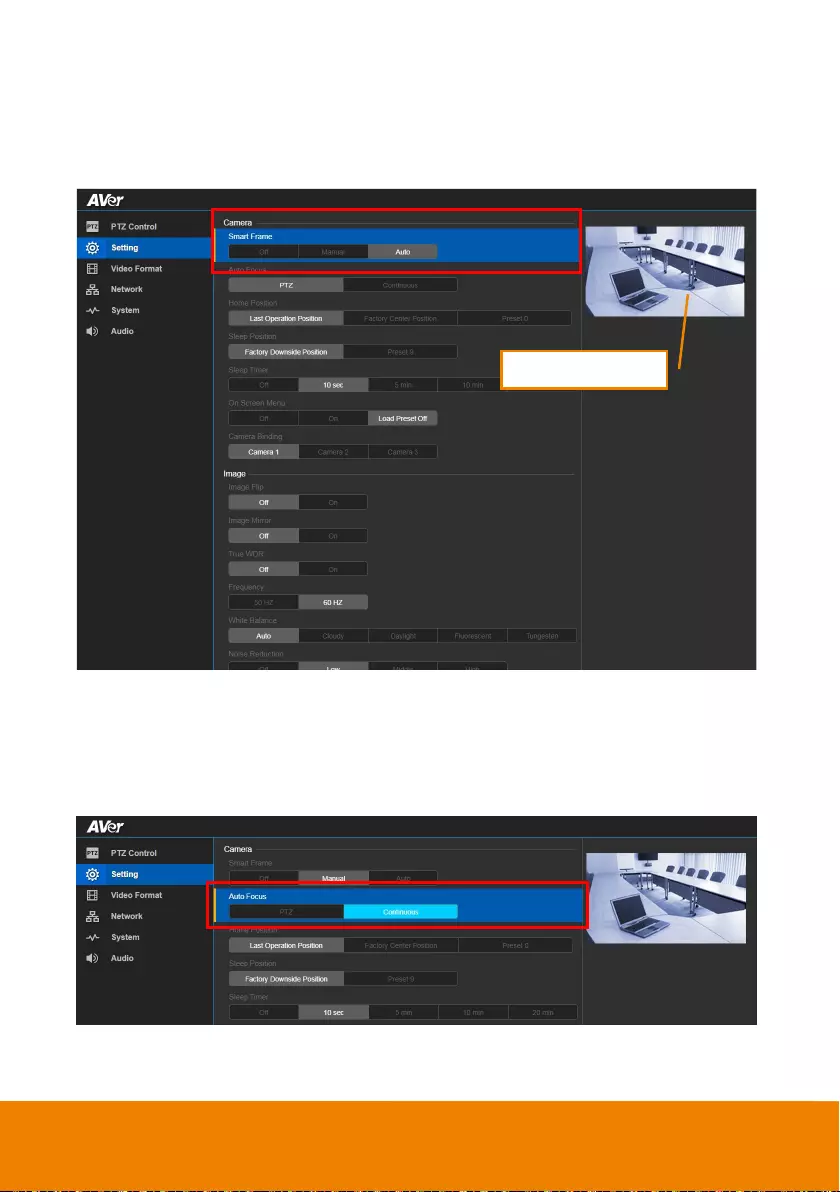
28
Camera Settings
Smart Frame
One-click automatic FOV(field of view) adjustment to fit all participants.
In live screen view, select Setting > Camera > Smart Frame > Auto, Manual or Off.
Auto Focus
Set auto focus mode.
In live screen view, select Setting > Camera > Auto Focus > PTZ or Continuous.
PTZ: By clicking the button(such as pan, tilt, zoom in/out) to adjust focus once.
Continuous: The camera will adjust the focus when the objects have moved.
Live screen preview

29
Home Position
Set the home positon for camera to return.
In live screen view, select Setting > Camera > Home Position > Last Operating Position, Factory
Center Position or Preset 0.
Sleep Position
When the camera idles for more than 3 minutes, it will enter sleep mode.
In live screen view, select Setting > Camera > Sleep Position > Factory Downside Position or
Preset 9.
Sleep Timer
Set the camera idle time to enter sleep mode.
In live screen view, select Setting > Camera > Sleep Timer > Off, 10sec, 5min, 10min or 20min.

30
On Screen Menu
Enable/disable on screen display status information.
In live screen view, select Setting > Camera > On Screen Menu > Off, On or Load Preset Off.
Camera Binding
With multiple cameras connection, users can set each camera to buttons 1 to 3 on the remote control.
In live screen view, select Setting > Camera > Camera Binding > Camera 1, Camera 2 or Camera 3.
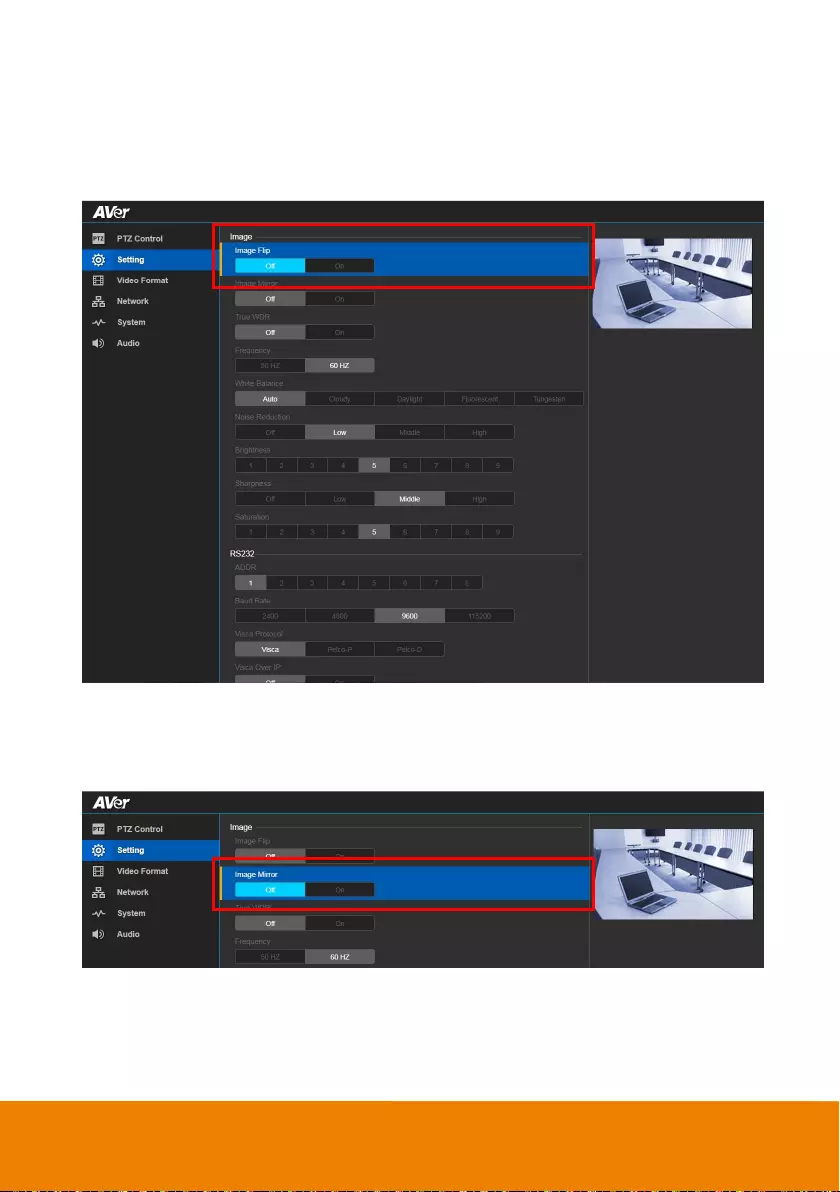
31
Image Settings
Image Flip
If the VC520 Pro is installed in the upside down position, please enable the "Flip".
In live screen view, select Setting > Image > Image Flip > Off or On.
Image Mirror
To mirror the camera image.
In live screen view, select Setting > Image > Image Mirror > Off or On.

32
True WDR
In back light environment, enabling WDR can improve the brightness of image.
Select Setting > Image > True WDR > Off or On.
[Note] While WDR is on, the frame rate will drop and cause image blur if there are moving objects.
Please turn off WDR when in normal light conditions.
Frequency
Select the frequency of the camera.
In live screen view, select Setting > Image > Frequency > 50Hz or 60Hz.

33
White Balance
Select the White Balance setting for various light conditions or color temperature.
In live screen view, select Setting > Image > White Balance > Auto, Cloudy, Daylight,
Fluorescent or Tungsten.
Noise Reduction
To reduce the noise from the signal.
In live screen view, select Setting > Image > Noise Reduction > Off, Low, Middle or High.

34
Brightness
Adjust the value of brightness.
In live screen view, select Setting > Image > Brightness > 1~9.
Sharpness
Adjust the value of sharpness.
In live screen view, select Setting > Image > Sharpness > Off, Low, Middle or High.
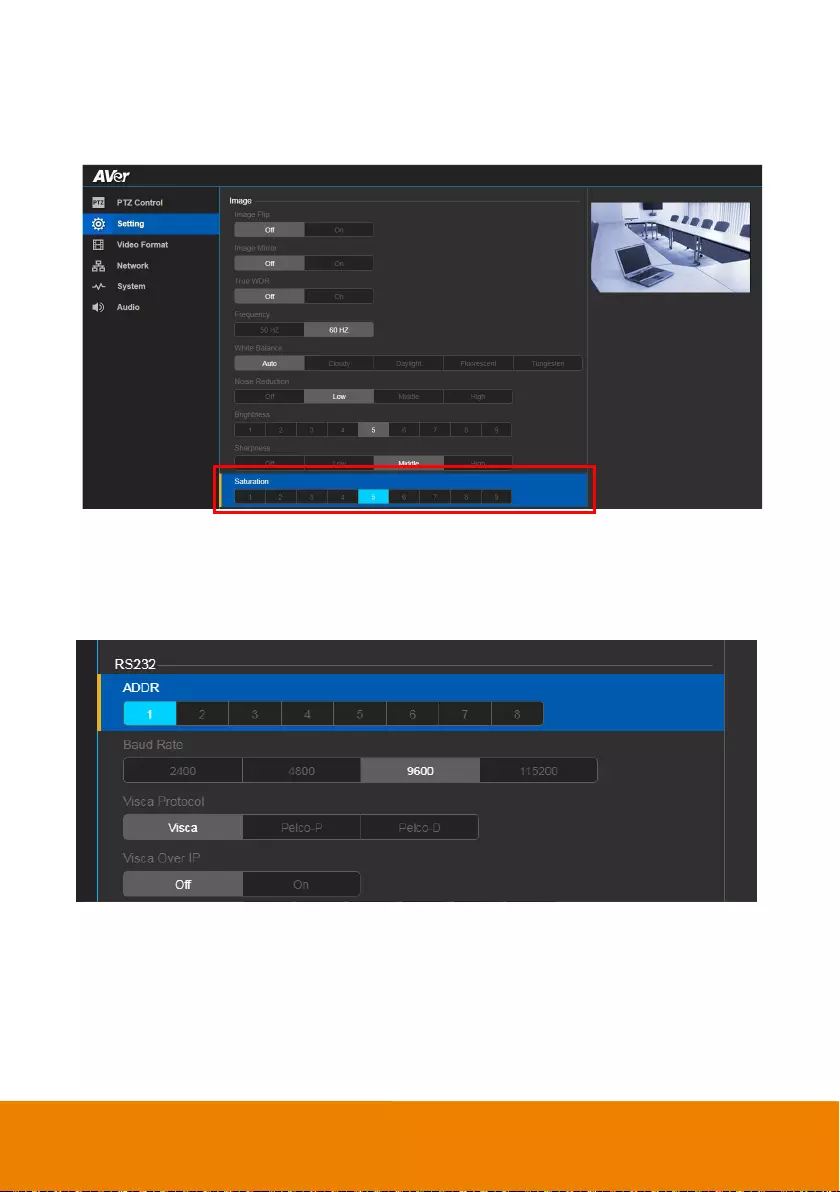
35
Saturation
Adjust the value of saturation.
In live screen view, select Setting > Image > Saturation >1~9.
RS232 Setting
When VC520 Pro connects with PTZ camera controller through the RS232 port, please setup ADDR,
Baud Rate, VISCA Protocol, VISCA Over IP settings.
In live screen view, select Setting > RS232.

36
Video Format Setting
IP Stream Resolution
Select the resolution for IP stream. Not supported for USB video stream.
In live screen view, select Video Format > IP Stream Resolution only(not for adjusting USB video
stream) > 1080P, 720P, 480P or 360P.
Frame Rate
Select the frame rate value.
In live screen view, select Video Format > Frame Rate > 60FPS, 30FPS or 15FPS.

37
Bit Rate
Select the bit rate value.
In live screen view, select Video Format > Bit Rate > Auto, 512Kbps, 1Mbps, 2Mbps, 4Mbps,
8Mbps, 16Mbps or 3Mbps.
RTSP
To use RTSP player connecting to the camera, please enter the RTSP URL which displays on the web
in your application such as VLC, PotPlayer or Quick Time.

38
Change RTSP Password
1. In live screen view, select Video Format > RTSP > Change RTSP Access Password.
2. Enter the new password.
3. Select “Change” to save the new password.

39
RTMP
Setup for uploading the camera’s live view to the broadcasting platform (ex: YouTube).
In live screen view, select Video Format > RTMP.
1. Locate the RTMP server URL and stream key from the broadcasting platform and enter in Server
URL and Stream Key column.
2. Select Start to begin uploading the live video of the camera to the broadcasting platform.
3. Select Stop to stop uploading the video.

40
Network Setting
DHCP
Enable/disable DHCP function.
In live screen view, select Network > DHCP > Off or On.
Static IP
Assign a fixed IP address to the camera. Please turn off the DHCP function.
1. In live screen view, select Network > Static IP.
2. Enter the IP Address, Gateway, NetMask, and DNS in the corresponding column.
3. Select Confirm to complete the setting.

41
System Setting
Language
Select the language of the system.
In live screen view, select System > Language > English or Traditional Chinese.
[Note] More languages will be added in the future without further notice.

42
FW Update
Update the camera’s firmware.
In live screen view, select System > FW Update > Auto Update or Manual Update.
Auto Update: The system will check firmware and update automatically. If the firmware is on the
latest version, then update will not perform.
Manual Update: To update the firmware from specific location.
After updating, the camera will reboot and the connection will be lost. User needs to re-connect after
rebooting.
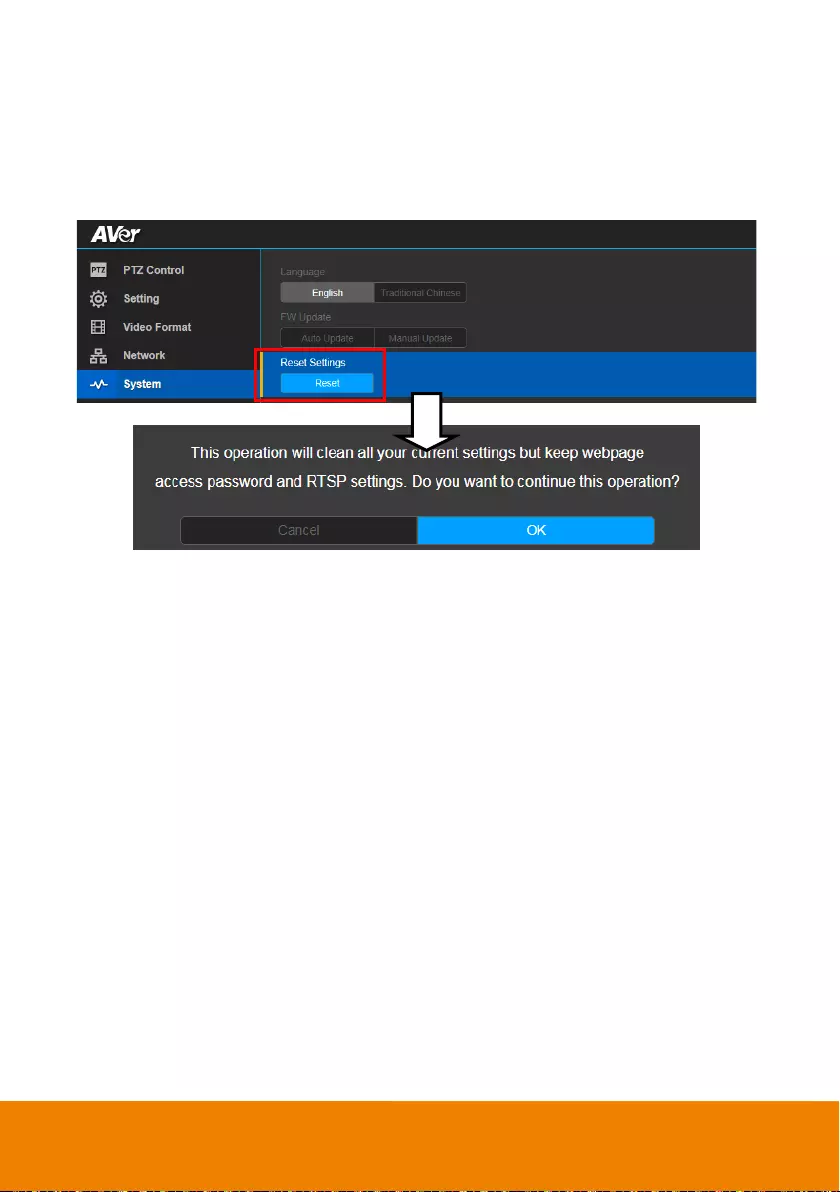
43
Reset Settings
Reset the camera back to factory default setting.
1. In live screen view, select System > Reset Settings.
2. Select Reset.
3. Select the OK to reset back to factory default.
[Note] When factory default is activated, the password of Webpage login and RTSP will not be set to
default.

44
Camera Reboot
Restart the camera manually.
1. In live screen view, select System > Camera Reboot.
2. Select Reboot.
3. Select the Continue to restart the camera.

45
Change Password
Change the Web login password. The default password is aver4321.
1. In live screen view, select System > Change Password > Change WEB Access Password.
2. Enter the old password, and then enter the new password.
3. Select Change to save the new password.
4. If users forget the password and want to revert back to the default password, please use PTZApp
(on FW update page) or OSD to reset it.

46
SSL Certificate
Import the SSL certificate from specific location.
1. In live screen view, select System > SSL Certificate.
2. Select the type by clicking +.
3. Direct the file location.
4. Select Import.

47
Date Format
Select the date format.
In live screen view, select System > Date Format > yyyy-mm-dd, mm-dd-yyyy, or dd-mm-yyyy.
Time Format
Select the time format.
In live screen view, select System > Time Format > 24-Hour or 12-Hour.

48
Time Correction Mode
Adjust time by auto or manual.
In live screen view, select System > Enable NTP > Auto or Manual.
Auto: The system time will be set by NTP server on the network. Enter the IP address of NTP
server and select the Time Zone. Select NTP Update to save setting. Select Activate to start auto
time adjustment.
[Note] Our default NTP server is located in the USA. If this does not work in your country, please
manually key in the desired NTP server.
Manual: User can set up time by manually. Enter the Year, Month, Day, Hour, and Minutes.
Select Confirm to save the settings.
Information
Display the information of Model Name, Firmware Version, Serial Number, IP Address, MAC
Address, and Time.
In live screen view, select System > Information.

49
Audio Setting
Noise Suppression
Enable/Disable reduce ambient noise.
In live screen view, select Audio > Noise Suppression > Off or On.
When enabling the reduced noise suppression function, please set the value of noise suppression (20
~ 40).
Automatic Gain Control
Enable/disable the automatic gain control.
In live screen view, select Audio > Automatic Gain Control > Off or On.

50
Echo Cancellation
Enable/disable echo situation.
In live screen view, select Audio > Echo Cancellation > Off or On.
Keyboard Noise Suppression
Enable/disable keyboard noise reduction.
In live screen view, select Audio > Keyboard Noise Suppression > Off or On.

51
Phone In Jack
Set Phone in input source.
In live screen view, select Audio > Phone In Jack > Phone In, 3.5mm External Microphone Only or
3.5mm External Microphone Mix In.
Phone in: When the mobile phone is connecting to Phone in port, please select “Phone in” option.
3.5 mm External Microphone Only: The speakerphone will transfer the sound that it receives
from the external microphone (connected on phone in port) to far site.
3.5 mm External Microphone Mix In: The speakerphone will transfer the sound that it receives
from the external microphone (connected on phone in port) and speakerphone to far site.

52
Operating the AVer PTZApp
Install AVer PTZApp
Please go to http://www.aver.com/download-center to download the AVer PTZApp. After downloading,
double-click on the file and follow the on-screen instructions to complete the installation.
Use AVer PTZApp to Setup the Camera
1. Run your video application.
2. During your video call, you can use the AVer PTZApp to pan, tilt and zoom the camera in/out and
enable/disable the backlight feature.
3. For the first time use, you can check the connection, camera, and setup the camera’s parameters.
Each function will be described below:

53
Currently selected device: This field displays currently selected VC, VB or CAM device
controlled by PTZApp. If you have more than one AVer VC, VB or CAM devices connected to this
PC/Mac PTZApp is running, you can click on the drop-down list to select other AVer VC, VB or
CAM device.
Function icon: Click it to switch to the function’s page.

54
PTZ: To control the camera direction, zoom in and out, and to enable/disable the backlight
compensation during your video call.
Smart Framing: One-click automatic FOV (Field of View) adjustment to fit all participants.
Click “Smart Framing” button to enable Smart Framing manually.
[Note] While in the video conference meeting, participants must face the camera for proper
face detection (SmartFrame). Side facial profiles are not detectable.
Settings: To setup parameters of the camera. Click the Save button to save all settings. To
change all the settings, back to the default values, click the Factory Default button.
Flip : If the VC520 Pro is installed in the upside down position, please enable the "Flip"
function in the AVer PTZApp , and the screen will display normally.

55
Tracking Mode: It is a SmartFrame function. One-click automatic FOV (Field of View)
adjustment to fit all participants. The user can set SmartFrame to manual, auto, or off mode.
When mode is off, the hotkey on the remote control cannot be used.
[Note] While in a video meeting, participants must face the camera for face detection. Side
facial profile is not detectable.
Diagnostic Utility: To display the S/W and F/W version and the devices connection status. You
can update the firmware of the camera and reset Web login password.

56
Minimize: Minimize the app to system tray. To quit the application, right-click the icon on the
system tray and select “Quit”.
: Click icon will launch the browser and connect to the AVer PTZApp web page.

57
(Camera): Click it to view the camera live view. Click the camera icon again to close the
camera live view. If the live video does not appear, please check the camera and the laptop/PC
connection to make sure all connections are correct and well connected.
Normal Un-normal
Connection diagnostic: Display devices connection status. If the AVer PTZApp has detected that
camera and laptop/PC are not connected well, the diagram will display an “?” on the camera to
indicate the connection has a problem. If the camera is in use by another application, it will display
“Can’t start video” warning. When the speakerphone cannot be detected, an “X” is display on the
diagram.

58
Test Camera: Click the “Test Camera” to check the camera video display status. You can adjust
the camera direction and view of the zoom in/out. To leave the page, click the Abort Diagnostic
button.
Test Speakerphone: Click to check the speakerphone status. It will require the user to record a
short message and play it back to ensure the speakerphone is working.

59
FW Update: Allows the user to update the VC520 Pro camera’s firmware.
1. Click” FW Update”.
2. A dialog will display the current firmware version and available new firmware version (internet
connection is required).
3. To auto update, click “Auto Update” and update process will start. The new firmware will be
downloaded first; then, the new firmware will be uploaded to the camera.
[Note] Please make sure camera, power, and laptop/PC are all well connected and stay
connected during the entire process.
4. To update the firmware manually, click “Manual Update” and locate the new firmware to start
the process.
Troubleshooting: Collect more system information for troubleshooting before you contact AVer
technical support.

60
Set the Camera Number
With multiple cameras connected, users can set each camera to buttons 1 to 3 on the remote control.
1. If PTZAPP detects the computer is connected to multiple VC/VB/CAM, you can select which
camera you like to control through the dropdown list.
2. Next, Click Change Binding button.
3. Select which camera number of remote control it maps to.
4. Click Save to save settings. To un-save the settings, click Abort.
[Note] If you only have one camera that requires no additional setting, the default is camera 1. If
camera 2 or 3 is selected, the remote will be unable to control the camera. In this case, please press
camera 1 on your remote.
1
2
3

61
Reset Password
Set Web access password back to default. The default password is “aver4321”.

62
Hotkey Control
Enable hotkey control to use keyboard control camera’s movement, backlight, and Smart Framing.
1. Select “Settings”
2. Set Hotkey Control to “On”.
3. A hotkey description as below figure shown:
4. When hotkey control is enabled, a hotkey tip will display when mouse is moved to the PTZ control
button in PTZ mode.
5. If the hotkey function is enabled after installed PTZApp, PTZApp auto launch next time PC reboot.
Therefore, the customer can use all the hotkey commands since PTZApp is auto running in
system tray.
1
2

63
Home / Sleep Position
Home Position: There are three options: Last operating position/Factory central position/ Preset 0.
Sleep Position: There are two options -- Factory sleep position/ Preset 9.
If the camera idles for more than 3 minutes, it will enter sleep mode.
ADDR / Protocol / Baud Rate
These settings are related to RS232 functions. Please choose the corresponding value while
connecting with external control panels.

64
OpenGL
The default setting is Off. If your PC has installed OpenGL, frame rate and video quality can be
improved if you turn it on. However, if your PC is without OpenGL, video display issues can arise if
OpenGL is enabled.

65
Use AVer PTZApp to Setup the Speakerphone
After installing the AVer PTZApp, run the PTZApp on your laptop/PC.
Select “Settings” > scroll down to “Speakerphone” section.
You can adjust the following settings of the speakerphone.
Noise suppression: Reduce ambient noise.
Automatic gain control: Enable/disable the automatic gain control.
Echo cancellation: Enable/disable echo situation.
Keyboard noise suppression: Enable/disable keyboard noise reduction.
Phone in jack
Phone in: When the mobile phone is connecting to Phone in port, please select “Phone in”
option.
3.5mm microphone only: The speakerphone will transfer the sound that it receives from the
external microphone (connected on phone in port) to far site.
3.5 mm microphone mix in: The speakerphone will transfer the sound that it receives from
the external microphone (connected on phone in port) and speakerphone to far site.

66
Install EZLive
Please go to http://www.aver.com/download-center to download the AVer EZLive software. After
downloading, double-click on the file and follow the on-screen instructions to complete the installation.
Use AVer EZLive
During a video call, EZLive can help user to do:
(1) Camera ePTZ
(2) Volume control for the speaker connected
(3) Capture camera’s still images
(4) Record video
(5) Live stream to Youtube, Livehouse.in, USTREAM…etc.
(6) Camera Zoom in/out
(7) Capture PC screen shot
(8) Record PC screen video
(9) Set up livestream
(10) Open file management to retrieve photos and video files
(11) Livestream setting
(12) Drawing tool.
(3)
(2)
(4) (5)
(7) (8) (9) (10)(11)
(12)
(6)
(1)